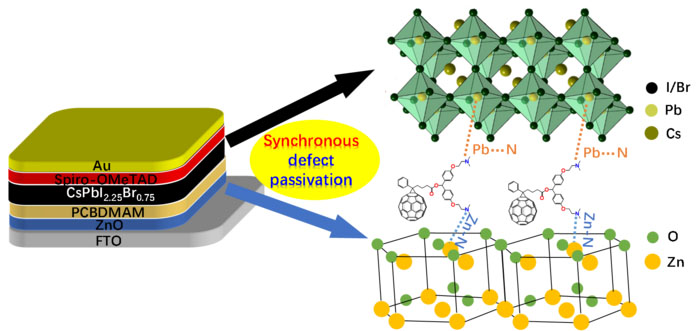| May 18, 2023 |
Boosting solar cell energy capture efficiency with a fullerene-derivative interlayer
(Nanowerk News) Solar cells are a critical component to the transition to renewable energy sources, and enhanced power conversion efficiency (PCE), or amount of power captured with a given amount of sunlight, increases the practicality of solar power in a society with high energy demands.
|
|
Perovskite solar cells that use all-inorganic perovskite light-absorbing materials are more thermally stable than organic-inorganic hybrid counterparts, but suffer from lower PCE.
|
|
Researchers have overcome this hurdle in all-inorganic perovskite solar cells (PSC) by adding a conductive fullerene-derivative interlayer to enhance PCE and thermal stability.
|
 |
| A bis-dimethylamino-functionalized fullerene derivative (PCBDMAM) interlayer between the ZnO electron transport layer and the all-inorganic CsPbI2.25Br0.75 perovskite layer of the perovskite solar cell improves power conversion efficiency by improving electron transport. (© Nano Research Energy, Tsinghua University Press)
|
|
All-inorganic perovskite solar cells have the advantage of increased thermal stability, which is critical for the longevity of solar cells, but lack in PCE compared to solar cells made with organic-inorganic hybrid counterparts.
|
|
A group of leading material scientists recently investigated the use of an interlayer to ameliorate the defects found in all-inorganic PSCs. In PSCs, layers of perovskite, a material that conducts energy when exposed to light, are susceptible to problems in morphology, energy level mismatches and electron traps that decrease electron transport and overall solar cell efficiency.
|
|
Introducing an interlayer of a fullerene derivative called bis-dimethylamino-functionalized fullerene derivative (PCBDMAM), sandwiched between the perovskite and the electron transport layer, remedies these deficiencies, increasing electron transport and PCE improving temperature stability.
|
|
The team published their findings in Nano Research Energy ("Synchronous defect passivation of all-inorganic perovskite solar cells enabled by fullerene interlayer").
|
|
“High-efficiency PSC devices are mostly based on organic-inorganic hybrid perovskite light-absorbing materials, which are intrinsically volatile and thermally unstable due to the existence of organic cations, resulting in poor thermal stability of PSC devices and hampering large-scale commercialization of organic-inorganic hybrid PSCs,” said Shangfeng Yang, lead principal investigator of the study and professor at the CAS Key Laboratory of Materials for Energy Conversion at the University of Science and Technology of China in Hefei, China.
|
|
“To enhance the PCE of [all-inorganic perovskite] PSCs, interface engineering has been extensively applied and demonstrated to be effective in promoting electron transport by improving film morphology, lowering the energy level mismatch and passivating the antisite traps in perovskite,” said Yang.
|
|
“By using different types of interlayers including small molecules, polymers, inorganic compounds, 2D perovskite layers as well as fullerene and its derivatives, defect passivations of all-inorganic PSCs have been accomplished,” said Yang.
|
|
In particular, the team used PCBDMAM as an interlayer between an all-inorganic perovskite layer and a zinc oxide electron transport layer. In this application, the PCBDMAM was spin-coated onto the zinc oxide surface as a conductive surface coating to mitigate the film morphology and other defects of the all-inorganic perovskite layer, improving the overall thermal stabilities of both the zinc oxide and perovskite layers and increasing PCE from 15.44% to 17.04%.
|
|
The successful transition to renewable energy sources depends, in part, on robust solar cells that can efficiently convert solar energy to electricity and withstand environmental extremes. Direct recombination, in particular, is a limiting factor in the efficiency of solar cells and presents a significant challenge for the research team and other material scientists. Direct recombination is the process by which electrons, created by light in the solar cell, and holes encounter one another and recombine. This recombination emits a photon, reversing electricity production in the solar cell.
|
|
The research team will continue to overcome hurdles to improve the functionality and lifespan of solar cells to make solar energy production more reliable and less expensive. Future challenges include further mitigating solar cell defects, including direct recombination, by altering the composition, concentration and application of solar cell layers to optimize temperature stability and efficiency in a commercially viable and cost-efficient way.
|

